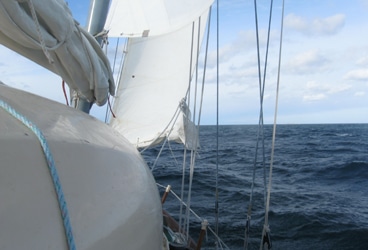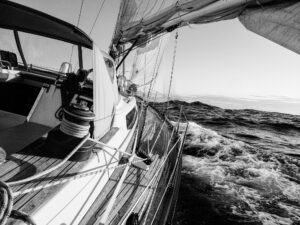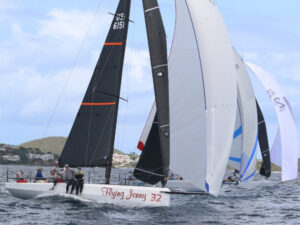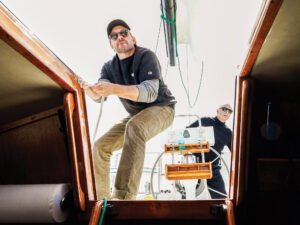
There was ice on Ganymede‘s decks the morning we left Harrington Harbor. No surprise—it had been chilly enough to have a roaring fire in our little wood stove the night before. Still, it added urgency to our already ardent desire to push south and west. Happily the wind was fair, if a little strong, and we made better than six knots all morning with two reefs in the mainsail, past all the “Bailout Options” I had noted on the chart—possible anchorages should the weather turn bad—through a maze of submerged rocks, around this island and that, on and on. It was a glorious run, and the wind lasted until we were just at Cape Whittle.
When we cruise, it seems that we can’t think further than one obstacle ahead. Whatever cape or tricky passage or bottleneck is approaching looms large in our minds, and we think, “Boy, if we can just get past that, we’ll be pretty happy.” And of course we always are, but another obstacle always seems to spring up ahead. Our previous Rubicon had been the Straits of Belle Isle, and once that was well astern we’d been planning for (or worrying about) Cape Whittle. It’s an unassuming little place to look at on the chart, just an island among several others, but it’s at a critical location, where the coast of Quebec turns abruptly to the west. Once past it we’d be out of the bit of the Gulf of St. Lawrence known as the “Northeast Gulf”, which is its own forecast region, mostly because everything coming from the SW gets squeezed in there and things can get pretty juicy. But Cape Whittle itself, when it isn’t blowing anywhere else, can still register 20-30 knot winds, and all the fishermen had warned us to be very careful in going around. One had done better yet, and shown me a hidey-hole just before the cape where they have moorings against just such weather events as we feared.
But we were spared any theatrics that day, and by the time the cape was abeam had shaken out all reefs, and finally fired up the engine to get some way on and put it astern. Turns out we need not have worried—at least not that day—though worrying for nothing doesn’t really bother me. It’s worrying and having my worst fears come true that gets upsetting.
There are very few decent harbors west of Cape Whittle, and we took advantage of the calm and rare lack of swell to continue another thirty miles to Washicouti Bay, where we could wait out the coming Sou’ wester in safety. We also needed a good place to celebrate Emily’s seventh birthday. For over a month now there’d been a daily countdown—“How many days ‘til my birthday? Will you count on the calendar?” and her excitement was at a fever pitch. She’d also noticed that we had not been near any stores for a long time, and was understandably concerned about presents. Happily, knowing this might be the case, I had started thinking about her birthday months before, and begun laying in tiny things back in St. John’s. A dollar-y sort of store in Twilingate had provided balloons, and in St. Anthony we had got the last few needful things. To help the excitement along and allay fears of any lack, Danielle had wrapped the presents a few days before and set them out, and Emily had spent hours counting them, turning them over, sorting them, and putting them away.
It was a record-setting day for us: 70 miles from first light to sunset, and here it was almost the equinox. We were ready to settle in to Washicouti for a couple of days of rest. It hardly mattered that there was no town or barely any place to land—we sat snug in the boat for several days while it rained and blew outside, and Emily had a wonderful birthday complete with a cake, marshmallows and the cabin festooned with festive bunting.
On the day after her birthday the wind changed to NE, which again was fair, though again was too hard for comfort. We had gotten our money’s worth out of that new storm sail already, and we got some more out of it that day as Ganymede hurried toward Natashquan. We made another long day of it, though perhaps in retrospect should have stopped a few miles sooner at Kegaska. We were served a stiff measure of tribulation on the very approach to the harbor, due in part to the confusion that surrounds the weather forecasting in those parts. On the VHF radio they issue two forecasts: one by Environment Canada, which is obviously geared at people who are wondering merely whether it will rain or be chilly that day, and probably stay indoors anyway. The other is a marine broadcast meant more for folk who may be outside, but the forecasts are notable in that though they’re issued together on the same frequency, they rarely agree.
So while one called for NE winds at 15-20 knots, the other called for E winds at 15 kilometers an hour. No big deal—whichever happened would be all right, though I don’t know how much 15 kilometers an hour is. The trouble is that both forecasts were dead wrong, and worse yet, while we were motor-tacking into a 25-30 knot blow from the north for two painful hours to make the last five miles into the harbor, the computerized Environment Canada radio voice assured us drily that at Natashquan the wind was NE at 15 kph. Perhaps they, like me, also don’t know how fast that is.
It’s not the first time a careless forecast has done us great evil, and it wasn’t the last either, but however often it happens it doesn’t get easier to take. Though not nearly as serious or dangerous as the unpredicted gale that had nearly put Ganymede on a Costa Rican beach several years before, it was egregious enough that if I had met the hapless meteorologist who wrote up that report I might have said something rude. It may be for the best, then, that when we tied up to the towering steel side of the commercial wharf there wasn’t a soul to be seen on the bleak and windswept landscape. As we fiddled with dock lines and fenders and took a look around, our ruffled feathers slowly settled and we were able to begin to feel pleased that we were not only around Cape Whittle, but nearly a hundred miles beyond toward the safety of lower latitudes and warmer spots.
We are the Zartman family: Ben & Danielle, and our three girls, Antigone, Emily and Damaris. We created this blog to chronicle our sailing adventures on Ganymede, a home-finished 31-foot gaff-rigged cutter, which has been our home since 2009, when we sailed from San Francisco, California, to the Sea of Cortez, then down along the Central American coast.








